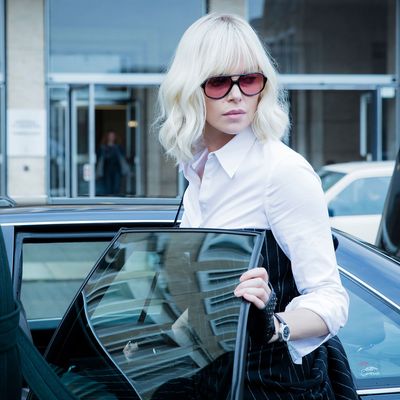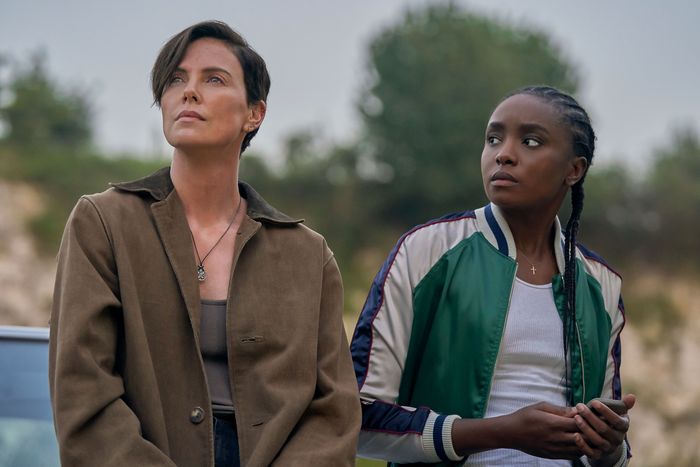
The first time we see Charlize Theron in Hancock, she’s emerging from a suburban house in a tasteful sundress, dish towel in hand, mouth pursed in a concerned moue. She’s playing, from all appearances, a variation on The Wife — that thankless figure who still toils at the sidelines of stories, periodically fretting about the choices made by the protagonist she’s married to. Theron’s character, Mary, does indeed spend the first half of the film staring skeptically at the drunken superhero of the title, played by Will Smith, when he comes over for dinner, eventually softening enough to plead with him not to let her husband (Jason Bateman) down. But then Hancock corners Mary in the kitchen one evening and she irritatedly hurls him through a wall to bounce off the pavement of the cul-de-sac, taking the fridge along with him. Mary, it turns out, has just been playing at being a soccer mom for this lifetime. She’s an immortal being herself, and when she crashes down on Hancock’s doorstep later, now dressed in black and sporting a smoky eye, the battle that ensues summons its own storm system.
Hancock, a star-driven, deconstructed-superhero oddity we really don’t talk about enough, came out in 2008, the same year Iron Man ushered in an era in which franchises, rather than celebrities, became the selling point for blockbusters. It wasn’t Theron’s first foray into action. Three years earlier, she’d followed up her Oscar win for Monster by starring in Æon Flux, a loose adaptation of a spiky MTV animated sci-fi series that bombed in theaters. The misbegotten, studio-mangled mess put director Karyn Kusama’s career on ice for years afterward, and while Theron’s own prospects weren’t as badly dinged, she still fretted that she wouldn’t get a second chance at a lead action role. That part in Hancock inadvertently plays like a reaction to what happened to her 2005 film — as though sneaking in under the guise of a forgettably normcore type were easier than seizing the spotlight outright.
It took Theron two decades to reach her current status as a full-blown action heroine, and she has arrived there at a time when asking audiences to invest in the pleasures of a particularly gifted performer instead of a property feels downright old-fashioned. Getting there involved significant accruing of power as a producer of her own projects as well as a performer, accompanying broader shifts in the industry, and, in general, just being very good at it. It definitely helps that she’s beautiful, thin, and white, attributes the movie industry has always preferred; being able to bemoan the quality of the roles being offered to you requires that you get offered those roles in the first place. But as a star, Theron has also been canny about how she feels women get pigeonholed onscreen, repeatedly citing blunt binaries in interviews. “There is a fantasy version of women in film, and they are not complex — they are great mothers or fantastic whores,” she said to The Scotsman in 2012.
When it comes to the action, there’s still a strong instinct to place women in supporting roles. “I got offered a lot of stuff in action movies that was either the girl behind the computer or the wife,” Theron told Variety in 2017 in a piece pegged to the release of Atomic Blonde, in which she plays a tough-as-nails spy who is neither of those things — and, pointedly, not an uncertain ingenue, either. That’s regular old bias, sure, but it also speaks to the limits of the industry’s imagination when it comes to what women-led action looks like. When Angelina Jolie (who was once offered a Bond-girl part and famously replied that she’d rather play James Bond) starred in her own espionage thriller, Salt, it was a project that had been written for a man and initially slated for Tom Cruise. While actresses like Pam Grier, Linda Hamilton, and Sigourney Weaver did pioneering work going back decades, you can still see the genre wrestling with itself and its ingrained tendency to treat femininity and action (both narratively and physically) as being at odds. One thing that has made Theron’s action fare so interesting is that it feels as if she’s constantly trying to calibrate a model of strength that doesn’t play as either re-skinned machismo or slogan-y corporate feminism.
In doing so, she has redefined what it looks like to be the veteran of the group, to have that position not hinge on grizzled physicality but on an aura of having endured unimaginable things. That Theron, a former dancer, does a lot of her own stunts is part of this. It pays off in set pieces that look more exciting and visually coherent for it, but the injuries she has accrued in doing them — landing on her neck during the filming of Æon Flux, cracking her teeth and bruising her ribs in Atomic Blonde — get held up as proof of her bona fides. While someone like Cruise, who has been similarly hurt on set, has built his current image on bouncing back and seeming bent on outrunning his own mortality, even if he has to travel to outer space to do it, a human capacity for wear and tear seems central to how Theron thinks of these roles, both in terms of the characters and her own experience of playing them. She actually considers the effects of time even when she’s playing near-deities who are untouched by it, allowing these characters to develop a kind of emotional patina.
It’s part of why they seem so easy in their skin — their gender not downplayed in an effort to be taken more seriously but their sexuality not angled as though it exists solely for the sake of outside consumption, either. When Lorraine Broughton, Theron’s icy-cold character in Atomic Blonde, falls into bed with a French agent played by Sofia Boutella, it’s a spectacle, sure, but it’s not offered up as any more of one than the staircase fight sequence that follows, brutal and unforgiving and shot to look like a single long take. There’s something in the greedy decadence of the sex that definitely recalls Bond, the character who defined the spy genre, though Boutella’s character is allowed more dimensionality than the standard Bond girl; she’s a participant in mutually desired tryst, not a notch on Lorraine’s bedpost, and when she meets an ugly end later, we feel it. We feel it when Lorraine takes a blow to the face or gets thrown against the wall, too, which is something Theron insisted on — when her character takes a beating, it shows on her bruised face and the blood-rimmed pupil of her eye. It makes sense that evidence of the combat, with its terrible solidity and won’t-cut-away immediacy, would show on Lorraine’s body and that those signs of vulnerability make it seem even more impressive.
Whether it’s a by-product of the timing of this turn in her filmography or an element of it, the fact that Theron became an action star mid-career is key to why she’s so resonant in these roles. She turned 40 three months after Mad Max: Fury Road premiered at Cannes in 2015, and while she looks largely the same now as she did when she got her start back in 2 Days in the Valley, she could bring a world-weariness to the part of Furiosa that felt extremely grown-up. With her haunted eyes and missing limb, Furiosa carries a whole history of loss and pain that doesn’t need to be explained to be felt onscreen. (Though it will, if Miller gets to make the prequel he’s planning — one in which he’ll cast a younger actress, though he considered having Theron de-aged, à la The Irishman.) Mad Max: Fury Road is another grittily physical movie, made primarily with practical effects and shot in grueling conditions, and Theron matched that sensibility by imbuing her character with a desperate determination. Furiosa is as much the hero as Tom Hardy’s Max Rockatansky, and one of the understated pleasures of the otherwise maximalist affair comes from both characters’ quick and unspoken recognition of the other’s formidability.
That sense of having lived through some shit is, if The Old Guard is any indication, now Theron’s signature. As Andy, née Andromache of Scythia, the longest-running member of the film’s collective of nearly unkillable soldiers, she wears the years in counterintuitive and considered ways. She does her best to bring an outrageous characterization down to the ground with Andy, playing her not as jaded but as someone to whom longevity has given an aura of intense surety. She moves with a muscular self-assurance in the role, whether in a fight or in a conversation had while prowling along a narrow street. When Andy yanks a dagger out of her chest, it’s with the tamped-down exasperation that someone might display when they’ve just been put back on hold while on the phone with their bank. When she comes back to gasping life after being shot repeatedly, it’s with the resigned readiness of someone who has done so countless times before. And when Andy and Nile (KiKi Layne) brawl in the tight quarters of a cargo plane in flight, what dawns on Theron’s face as she shows off the martial-arts training she has been accruing is an unexpected look of delight. It’s a sign that her character can still take pleasure in a fight and that, after so many millennia, the world still holds some surprises for her.
Theron herself has already lived multiple lives in the industry. She started off playing the sex kitten in films like That Thing You Do! and Reindeer Games, then painstakingly navigated her way into the kind of chameleonic, deglamorized parts so often regarded as markers of artistic gravity, like her roles in Monster and North Country. She hasn’t left that behind — just last year, she put on prosthetics and lowered her voice to appear as Megyn Kelly in Bombshell — but as she has gained more sway over the projects she opts to appear in, she has gravitated toward a particular kind of action the most. It’s one that feels related in battered spirit to the spate of movies over the past decade-plus starring Liam Neeson, Keanu Reeves, and Denzel Washington as seasoned characters dragged back into the game. But in other ways, it doesn’t — not just because Theron is younger, but her characters aren’t getting pulled out of retirement. They never left, and they’re still in their prime. To play the character at the center of the story, to be active instead of watching in the wings — that’s power. But more powerful still is to be the character who has been at the center for a while, and who brings the weight of that past with her going forward.




